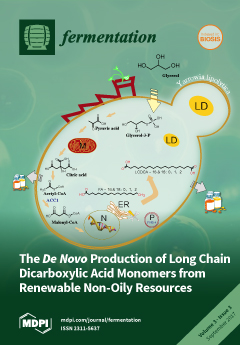Among other fermentation processes, lactic acid fermentation is a valuable process which enhances the safety, nutritional and sensory properties of food. The use of starters is recommended compared to spontaneous fermentation, from a safety point of view but also to ensure a better
[...] Read more.
Among other fermentation processes, lactic acid fermentation is a valuable process which enhances the safety, nutritional and sensory properties of food. The use of starters is recommended compared to spontaneous fermentation, from a safety point of view but also to ensure a better control of product functional and sensory properties. Starters are used for dairy products, sourdough, wine, meat, sauerkraut and homemade foods and beverages from dairy or vegetal origin. Among lactic acid bacteria,
Lactobacillus,
Lactococcus,
Leuconostoc,
Streptococcus and
Pediococcus are the majors genera used as starters whereas
Weissella is not.
Weissella spp. are frequently isolated from spontaneous fermented foods and participate to the characteristics of the fermented product. They possess a large set of functional and technological properties, which can enhance safety, nutritional and sensory characteristics of food. Particularly,
Weissella cibaria and
Weissella confusa have been described as high producers of exo-polysaccharides, which exhibit texturizing properties. Numerous bacteriocins have been purified from
Weissella hellenica strains and may be used as bio-preservative. Some
Weissella strains are able to decarboxylate polymeric phenolic compounds resulting in a better bioavailability. Other
Weissella strains showed resistance to low pH and bile salts and were isolated from healthy human feces, suggesting their potential as probiotics. Despite all these features, the use of
Weissella spp. as commercial starters remained non-investigated. Potential biogenic amine production, antibiotic resistance pattern or infection hazard partly explains this neglecting. Besides,
Weissella spp. are not recognized as GRAS (Generally Recognized As Safe). However,
Weissella spp. are potential powerful starters for food fermentation as well as
Lactococcus,
Leuconostoc or
Lactobacillus species.
Full article





